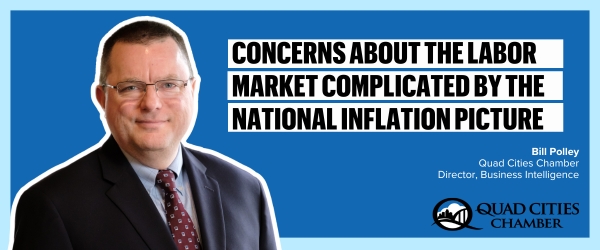Weekly Economic Trends and Indicators

The National Headline:
According to the Bureau of Labor Statistics (BLS), total nonfarm payroll employment in the U.S. increased by 275,000 in February. The national unemployment rate increased from 3.7% to 3.9%. Most of the strength was in service-producing industries with health care and social assistance accounting for about a third of the net gain in jobs.
Local Statistics:
In a separate report, the BLS announced that the total nonfarm payroll employment in the Quad Cities area was down by 2,500 in January from the same month in 2023. The local unemployment rate rose from 3.9% in December to 5.2% in January. Manufacturing employment was down 800 from a year ago, but still near decade-high levels. The largest area of weakness in the job market locally was in business and professional services, which was down 2,300 jobs since last January. Leisure and hospitality jobs were down 300 jobs since last January—the first year-on-year decline in jobs in that category since the start of the COVID-19 pandemic.
The Context:
Nationally, the strong labor market numbers, combined with an uptick in inflation, will likely keep the Federal Reserve from making any interest rate cuts until well into summer. Consumer spending remains very strong, but cracks in the façade are starting to appear.
As we have been following for several months now, manufacturing has slowed down locally, and even nationwide it would be fair to say that manufacturing is in a fairly deep slowdown if not a recession. We discussed the notion of “rolling recession” in the Q2 Quarterly Market Report last year. The situation that was developing then seems to now be in full swing. Manufacturing has slowed while the rest of the economy remains quite strong. Lower interest rates would help manufacturing bounce back, but risk re-igniting overall inflation. It’s a tough problem for the Fed.
Will the rate cuts come in time to prevent the slowdown that is underway in manufacturing and could be developing in business and professional services from spreading to the overall economy? Time will tell. However, part of the strength of the consumer may be a result of a wealth effect from the booming stock market. If the stock market rally fades, consumer sentiment may fall with it, which would increase recession risk and force the Fed’s hand. This is all further complicated by election year uncertainty over the course of fiscal policy.
The local increase in unemployment is something to watch but is not out of line with past experience. January is typically the month of highest unemployment in the Quad Cities, and while the increase was sharp, the rate itself at 5.2% is on par with or lower than many January readings pre-COVID. The decline in professional and business services continues a trend that has been developing over the last several months and definitely bears watching.
Next week: Inflation and Federal Reserve Recap





